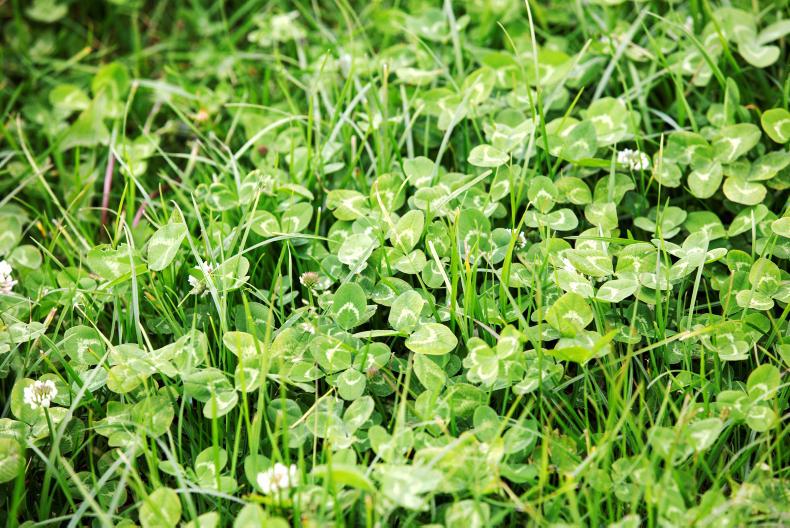With the focus of sustainability becoming stronger on farms, is there a role for more clover in the grass-based system?
Teagasc research farm in Clonakilty has been running clover trials over the last number of years and have seen several benefits to the clover-based sward.
Increased milk solid production of +30kg MS/cow/year and an increased grass dry matter production of +800kg DM/ha was seen.
This was from grass clover sward receiving 150kg N/ha/year compared with grass-only sward receiving 250kg/N/year.
Main benefits
The reduced nitrogen level is the main benefit seen from an environmental point a view. However, the reduced level of nitrogen will also have a positive effect on profitability, as you are growing more grass with less inputs.
This was down to clover's ability to fix its own nitrogen. It’s important to note that as nitrogen application increases, the ability of the clover to fix nitrogen significantly reduced.
White clover swards can fix up to 100kg to 250kg N/ha/year. An average annual sward clover content of at least 20% is required for N fixation.
As nitrogen application rates increases, N fixation generally declines.
Efficiency
Nitrogen use efficiency is becoming very important in grazing systems. Nitrogen use efficiency increased from 40% in a 250kg N/ha grass-only sward to 59% in a 150kg N/ha grass-clover sward.
Milk solids production was greater on the grass-clover treatments compared with grass only.
As the white clover content decreased in the sward over time, the beneficial effects of white clover on milk and grass DM production were reduced.
In Clonakilty, the clover content reduced from 25% in 2015 to 18% in 2016 to 15% in 2017.
Where to start to establish a white clover sward
Target high-fertile soils - recommended are index 3 and 4 for phosphorus (P) and potassium (K), with a soil pH close to 6.3.
Sowing should be done in the spring or early summer preferably. Sow the seed to a depth of 10mm to 12mm at a sowing rate of 1.2kg to 3.7kg/ha (0.5kg to 1.5kg/ac) and roll post-sowing.
If over-sowing, ensure existing sward has a high perennial ryegrass content and you sow immediately after grazing or silage been cut at a rate of 3.7kg to 5kg/ha (1.5kg to 2kg/ac) and roll.
Graze the paddock at a pre-grazing yield <1,100kg/ha for the next three rotations to allow clover to establish.
Getting a sward with 25%+ clover establishment is very important, along with sticking to the lower chemical nitrogen levels to get the full benefits. Persistence seems to be an issue and soil fertility may also need to be right to achieve a high clover establishment in the sward.However, there is definitely huge benefits towards sustainability of farms and is definitely worthwhile having a certain percentage of the grazing block in grass clover.
With the focus of sustainability becoming stronger on farms, is there a role for more clover in the grass-based system?
Teagasc research farm in Clonakilty has been running clover trials over the last number of years and have seen several benefits to the clover-based sward.
Increased milk solid production of +30kg MS/cow/year and an increased grass dry matter production of +800kg DM/ha was seen.
This was from grass clover sward receiving 150kg N/ha/year compared with grass-only sward receiving 250kg/N/year.
Main benefits
The reduced nitrogen level is the main benefit seen from an environmental point a view. However, the reduced level of nitrogen will also have a positive effect on profitability, as you are growing more grass with less inputs.
This was down to clover's ability to fix its own nitrogen. It’s important to note that as nitrogen application increases, the ability of the clover to fix nitrogen significantly reduced.
White clover swards can fix up to 100kg to 250kg N/ha/year. An average annual sward clover content of at least 20% is required for N fixation.
As nitrogen application rates increases, N fixation generally declines.
Efficiency
Nitrogen use efficiency is becoming very important in grazing systems. Nitrogen use efficiency increased from 40% in a 250kg N/ha grass-only sward to 59% in a 150kg N/ha grass-clover sward.
Milk solids production was greater on the grass-clover treatments compared with grass only.
As the white clover content decreased in the sward over time, the beneficial effects of white clover on milk and grass DM production were reduced.
In Clonakilty, the clover content reduced from 25% in 2015 to 18% in 2016 to 15% in 2017.
Where to start to establish a white clover sward
Target high-fertile soils - recommended are index 3 and 4 for phosphorus (P) and potassium (K), with a soil pH close to 6.3.
Sowing should be done in the spring or early summer preferably. Sow the seed to a depth of 10mm to 12mm at a sowing rate of 1.2kg to 3.7kg/ha (0.5kg to 1.5kg/ac) and roll post-sowing.
If over-sowing, ensure existing sward has a high perennial ryegrass content and you sow immediately after grazing or silage been cut at a rate of 3.7kg to 5kg/ha (1.5kg to 2kg/ac) and roll.
Graze the paddock at a pre-grazing yield <1,100kg/ha for the next three rotations to allow clover to establish.
Getting a sward with 25%+ clover establishment is very important, along with sticking to the lower chemical nitrogen levels to get the full benefits. Persistence seems to be an issue and soil fertility may also need to be right to achieve a high clover establishment in the sward.However, there is definitely huge benefits towards sustainability of farms and is definitely worthwhile having a certain percentage of the grazing block in grass clover. 





 This is a subscriber-only article
This is a subscriber-only article










SHARING OPTIONS: